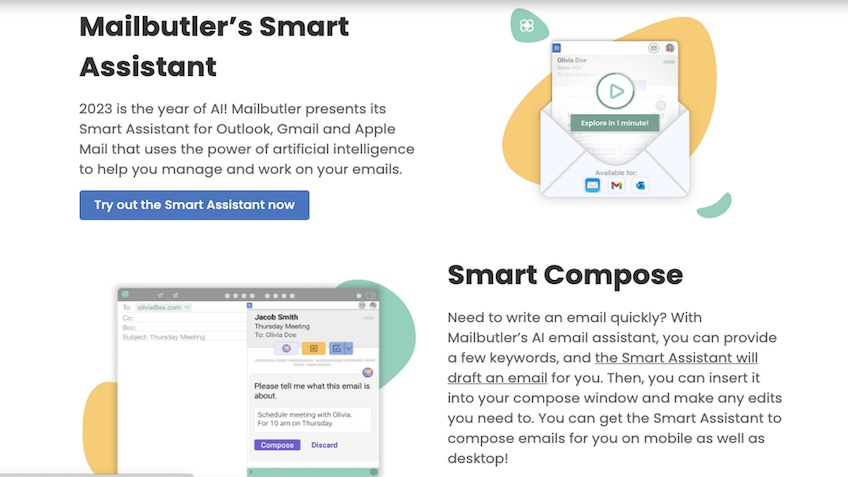Whether you’re using emails for general communication, client tracking, or just plain old sales conversions, email still reigns supreme as the medium in which to get these things done well—just not if you’re still using a standard email client with an ordinary inbox and lackluster features.
What you need is a tool that supercharges your inbox with superb email tracking, fully detailed client cards, and even AI-integrations to help you greatly improve and automate your email workflow.
If you’re not familiar with Mailbutler by now, it’s high time you get familiar.
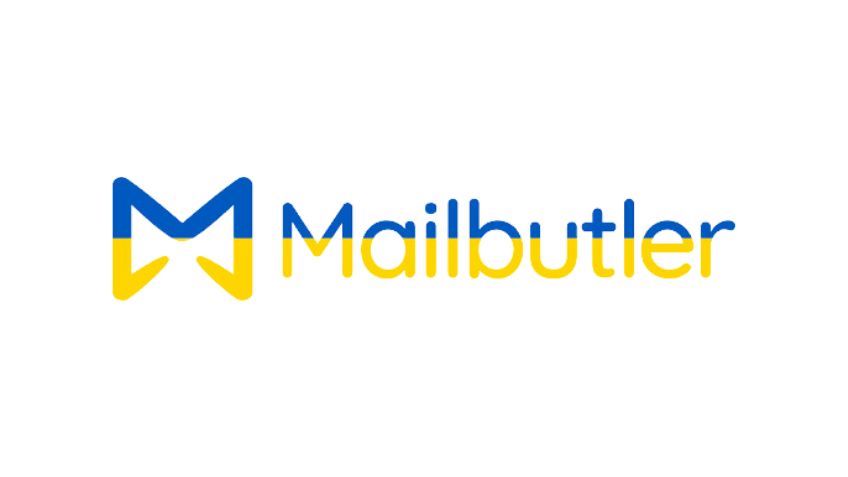
Who Mailbutler Is For
Mailbutler is an email productivity tool built for busy professionals who rely heavily on frequent email communication to get work done. If you spend your days buried in an overflowing inbox, collaborating with team members, or communicating back-and-forth with clients, Mailbutler can help optimize your workflow.
Specifically, Mailbutler shines if you use Outlook, Gmail, or Apple Mail and want to integrate productivity enhancements directly into your existing email client. The extension adds useful features like email tracking, message scheduling, signatures, tasks, notes, templates, snoozing, and even AI-powered writing assistance.
For entrepreneurs, freelancers, and remote teams, Mailbutler makes communicating over email more efficient for working collaboratively, delegating tasks, and sharing templates or contacts. The built-in tracking also helps you see who’s engaging with your outreach campaigns.
For marketing and sales teams, Mailbutler is invaluable for optimizing drip campaigns, cultivating leads, and analyzing email performance. You can segment contacts, personalize outreach, and track engagement every step of the way.
However, if you rarely use email in your work, or if you still prefer manual control over email management, Mailbutler may feel like too much too soon. Similarly, if you work mainly in a different email client like Yahoo or Outlook.com, Mailbutler’s functionality will be limited.
In these cases, a more generalized email management platform may be better. Meanwhile, For power emailers on Outlook, Gmail or Apple Mail looking to enhance their existing workflows, Mailbutler can be an inbox game-changer.
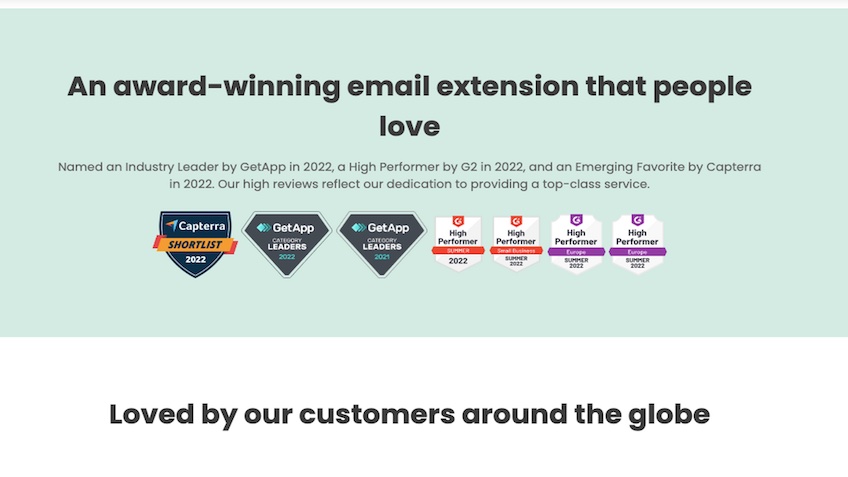
Mailbutler Pricing
Mailbutler offers four paid plans, ranging from basic email tracking to fully featured automation with AI integrations. Before that, however, it also offers a very generous 14-day trial to get your hands dirty.
Once your trial is up, you can hop onto the Tracking plan for $49.50 per year for each user. It provides email opens and link tracking, real-time notifications, and basic support. It’s best for solo entrepreneurs who just want simple email analytics.
The Professional plan costs $89.50 per user annually and adds powerful productivity features like send-later scheduling, signatures, snoozing, templates, notes, tasks, and contact management. It’s ideal for entrepreneurs, freelancers, and remote teams looking to collaborate more efficiently.
For $149.50 per user per year, the Smart plan includes all previous plan features plus Mailbutler’s AI assistant for writing, proofing, and summarizing emails. You also get advanced tracking insights and send-time optimizations. This plan is perfect for sales teams, agencies, and other power users.
Finally, the Business plan comes in at $329.50 per user annually and lets you blacklist internal email tracking, and it also provides priority support. This premium plan suits large enterprises with complex needs.
The main differences between all the plans really comes down to tracking, automation, and AI integration.
The Professional plan adds just about everything except for some key automations and AI capabilities. The Smart plan ratchets things up with just about everything that Mailbutler has to offer—minus IP blacklisting, which is the final piece of the puzzle you get at the top-tier Business plan.
Be sure to compare features to find the right plan for your email productivity and collaboration needs.
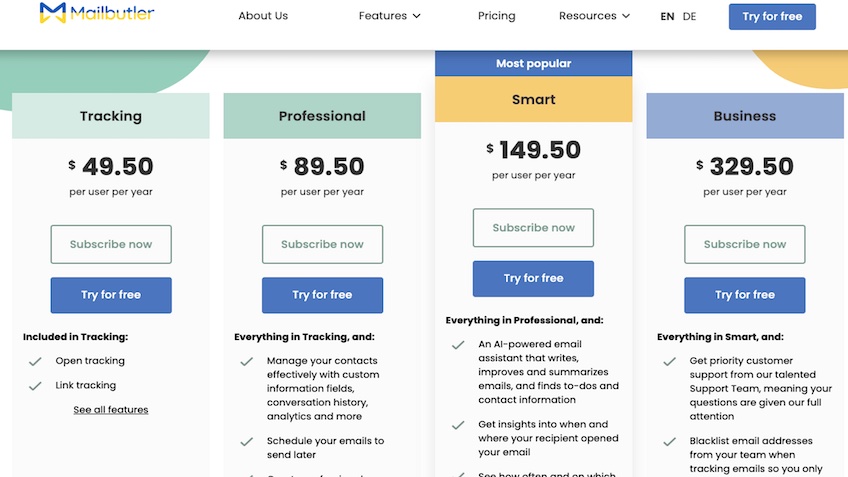
Pros and Cons of Mailbutler
There’s a lot to appreciate about what Mailbutler has to offer. Many of its features, such as notes, tasks, and collaboration tools can be integrated into your email workflow fairly easily. That said, Mailbutler does have some hiccups to look out for.
Depending on your screen size, the side panel design can feel a bit intrusive, and the overall functionality may not be as smooth as you’d want it to be. This calls into question whether or not the pros outweigh the cons, especially for the price point.
Mailbutler Pros
- It’s easy to set up and get started. Mailbutler integrates directly into your existing email client like Outlook or Gmail, so it’s a plug-and-play service with no complicated setup needed.
- It comes with a lot of customizability options. You can tweak Mailbutler’s settings and features to match your preferences and needs.
- The email tracking feature is good for seeing who opened your emails and clicked your links, and you can get notified in real-time.
- Automation and scheduling features let you send emails at optimal times, set reminders, and automate follow-ups.
- You can easily attach action items and additional info to your emails and contacts by using the notes and task features.
- Its contact cards make it easy to build rich profiles for your best contacts right inside your inbox.
- There’s a smart assistant that can generate emails, improve spelling and grammar, and auto-extract tasks for you.
- If you need to hide emails from your inbox to revisit later, you can do so with the email snooze feature.
- It comes with solid collaboration tools so that your entire team can access templates, signatures, notes, and tasks.
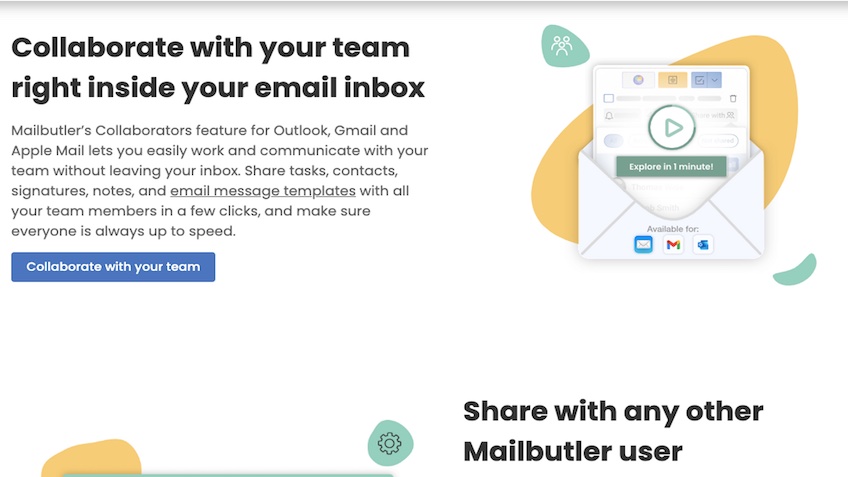
Mailbutler Cons
- The side panel is intrusive. Mailbutler’s interface sits alongside your inbox, taking up precious screen space.
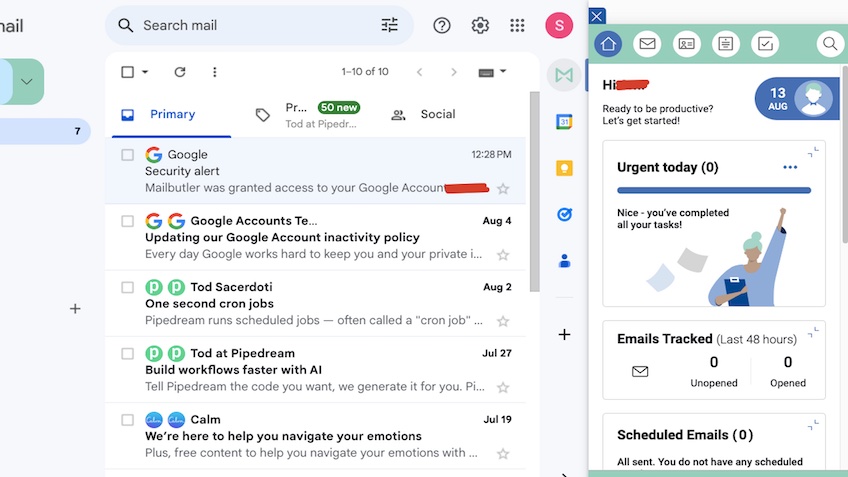
- The extension can be glitchy in places depending on your email client. We encountered some performance issues like lag or crashes in Gmail.
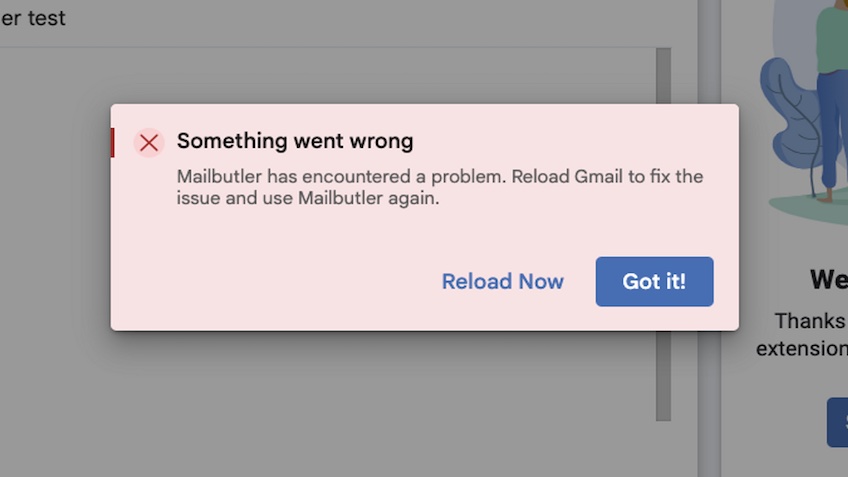
- There’s a learning curve for all the features. With so many capabilities packed in, you’ll have to account for a ramp-up period before you can extract the most value out of it.
- It can be expensive for what it offers. Mailbutler is typically pricier than some alternative email productivity tools.
- If you have multiple email accounts that you want to keep separate, Mailbutler makes this a bit tricky. It automatically installs itself across all of your accounts, not just one inbox. That said, you still have to enable access manually thereafter.
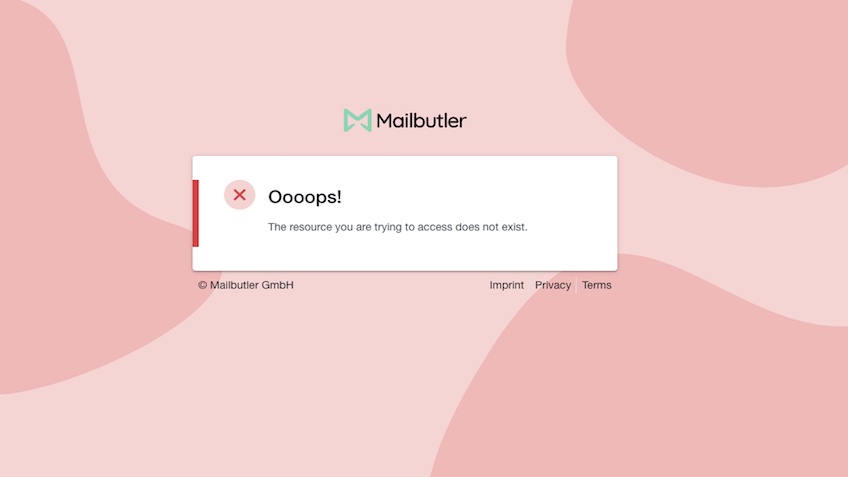
Mailbutler Review: The Details
For a simple extension that integrates into your email inbox with just a few clicks, there’s a lot going on under the proverbial hood of Mailbutler. Once you get through the initial setup, you’re likely to be impressed. From the thoroughness of the contact cards to the well-integrated functionally of the AI, it makes it pretty easy to spice up your email workflow.
Easy setup: First of all, testing out the product with the free trial gives you 14 days to evaluate if Mailbutler fits your needs, with no credit card required.
As a browser extension, installation is always just a couple of clicks away. Since Mailbutler is built for Google Chrome, Firefox, and Microsoft Edge, the add-on integrates seamlessly.
Once installed, you’ll need to create a Mailbutler account to unlock the features. You can register your email address on the website directly or through the extension itself.
With an account created and your Gmail, Outlook, or Apple Mail inbox opened up. You’ll see Mailbutler’s side panel ready to go. Although the panel may feel intrusive to some, it can also collapse when not in use, so it doesn’t always have to take up a lot of space.
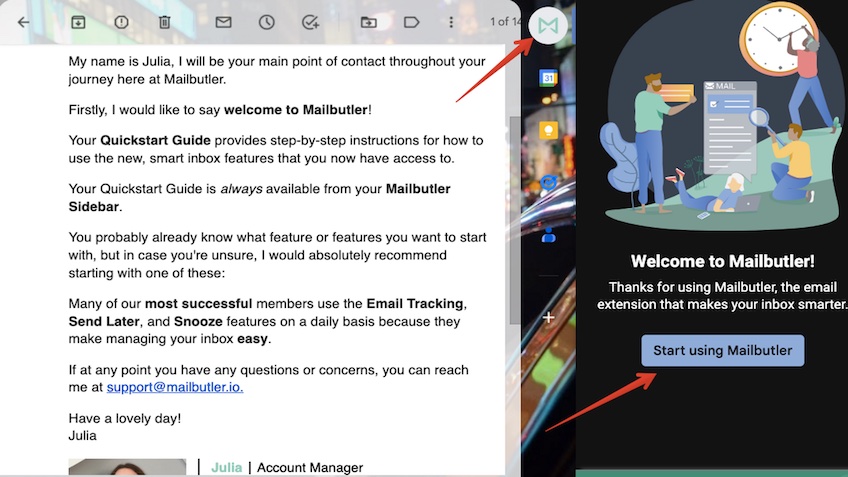
Before using the features, you have to authorize Mailbutler access to your inbox. This allows the technology to work its magic.
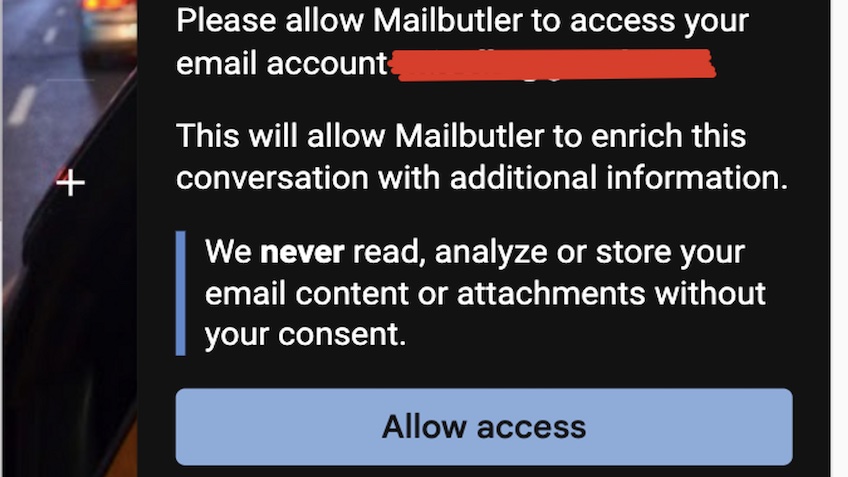
Next, open the Quick Start guide in the Mailbutler settings. This handy floating UI tutorial walks you through how to use all the key features step-by-step. It’s incredibly thorough and allows you to learn without leaving your inbox.
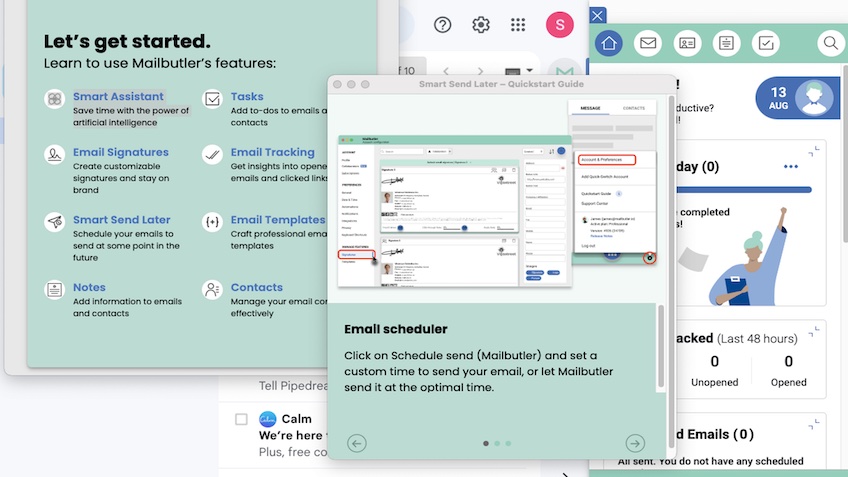
Because Mailbutler sits alongside your email as a productivity add-on, you can go about emailing as usual. When you need to leverage one of its capabilities like tracking or scheduling, simply crack open that side panel, and you’ll be up and running with a smarter inbox in no time.
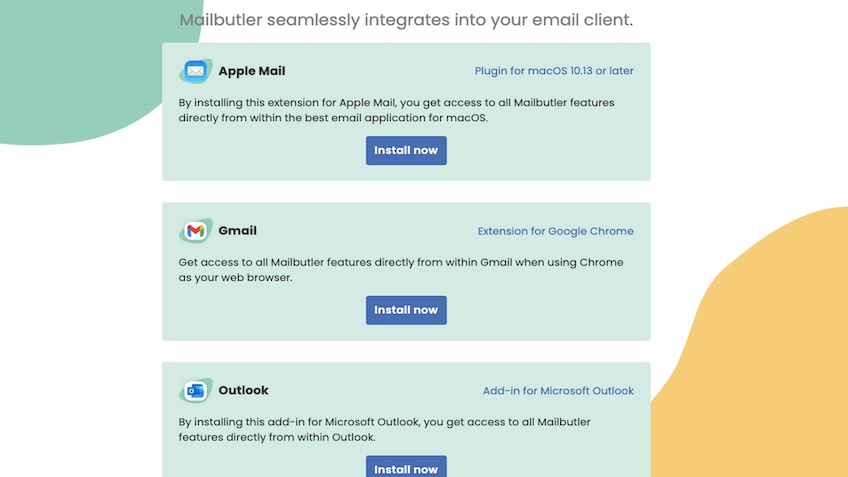
Email tracking: Mailbutler provides robust email tracking capabilities directly within your Gmail, Outlook, or Apple Mail inbox.
You can see real-time notifications when recipients open your emails or when they click on any links you included. This helps you know if your messages are truly engaging or not.
Beyond mere open tracking, Mailbutler also shows you additional insights, such as the geographic location or region where the email was opened, how many times it was opened, and frequency data on link clicks. This paints a fuller picture of how your audience interacts with your emails.
Mailbutler’s tracking integrates notifications right into your inbox, too. As soon as someone opens or clicks, you’ll know about it without having to check any external dashboard.
If you need to customize who gets tracked, the platform allows you to exclude certain contacts, segments, or domains from tracking if desired. This ensures you only receive actionable notifications.
And the best part? All of this tracking data appears in the side panel within your email client, so you never have to go anywhere else or change your workflow to reap the benefits.
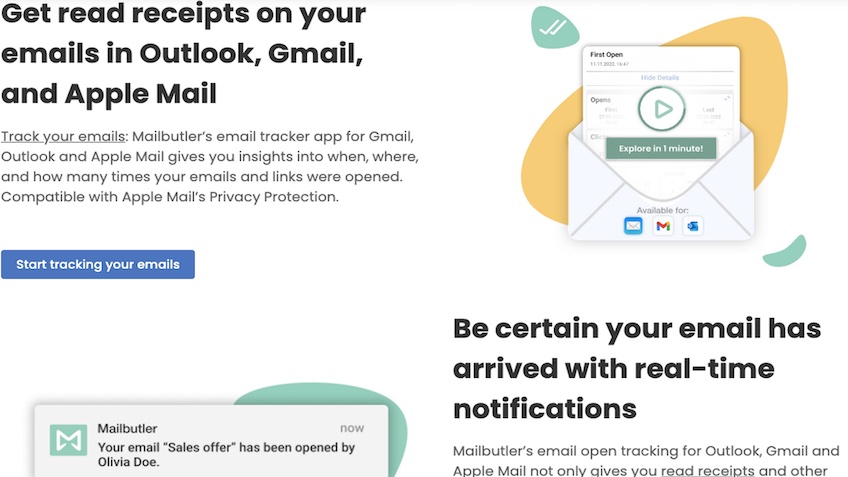
Contacts: Mailbutler makes it easy to manage all of your contacts directly within your email inbox.
For each contact, Mailbutler automatically generates a complete profile card showing useful details like response time, past email history, custom fields, notes, and tasks. Another feature we found especially useful was how it includes suggested and/or optimal contact times.
The response time insight shows how long on average the contact takes to open your email and reply back. This helps inform your outreach cadence.
Mailbutler also calculates the best times during weekdays and weekends to reach each contact based on their historical email activity. You can schedule messages accordingly to improve open and response rates.
Each contact card is fully customizable as well—you can add custom fields like birthday, number of kids, hobbies, or anything else unique to that relationship. This extra context helps personalize and improve future communications.
All past email exchanges with the contact are compiled chronologically so you can easily reference your conversation history on relevant topics, agreements made, or outstanding items.
Notes and tasks can be attached to contacts for quick reference, action items, and keeping pertinent information top of mind.
Lastly, Mailbutler even lets you selectively share contact cards and notes with colleagues. This facilitates better collaboration while respecting privacy where appropriate.
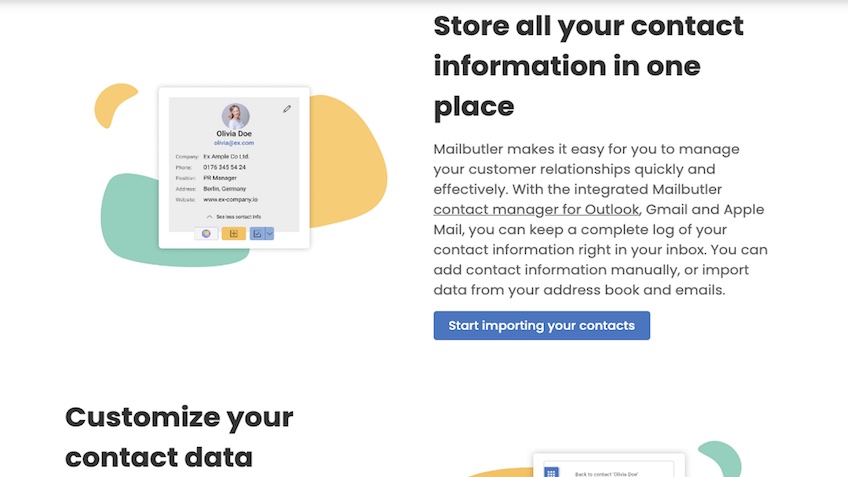
Intelligent scheduling: Mailbutler’s Smart Send Later feature gives you complete control over when your emails get delivered.
You can schedule emails to be sent automatically at any future date and time. This prevents having to send time-sensitive emails manually, whether late at night or early morning.
For recipients in different time zones, you can optimize delivery times based on their location. This results in higher open and response rates, when used properly.
Mailbutler even suggests the best send times for each recipient using historical data on their email activity patterns. The AI identifies when they are most likely to open and engage.
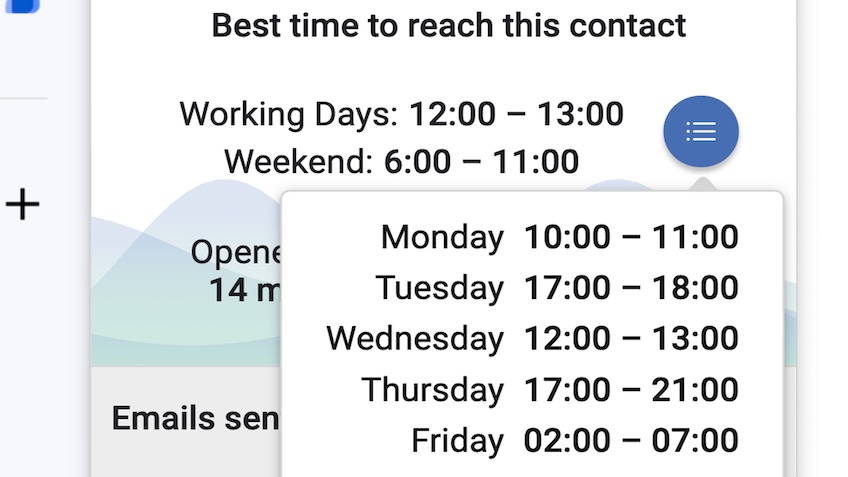
All scheduled emails are saved in a dedicated Smart Send Later folder. You can modify or unschedule any message before it goes out.
Once sent, scheduled emails look like normal messages to recipients. But you have the benefit of controlling exactly when they get delivered.
Whether you want to set specific send times or leverage Mailbutler’s AI suggestions, Smart Send Later takes the guesswork and hassle out of email delivery. Your messages will reach inboxes at just the right moment—and deliverability is key.
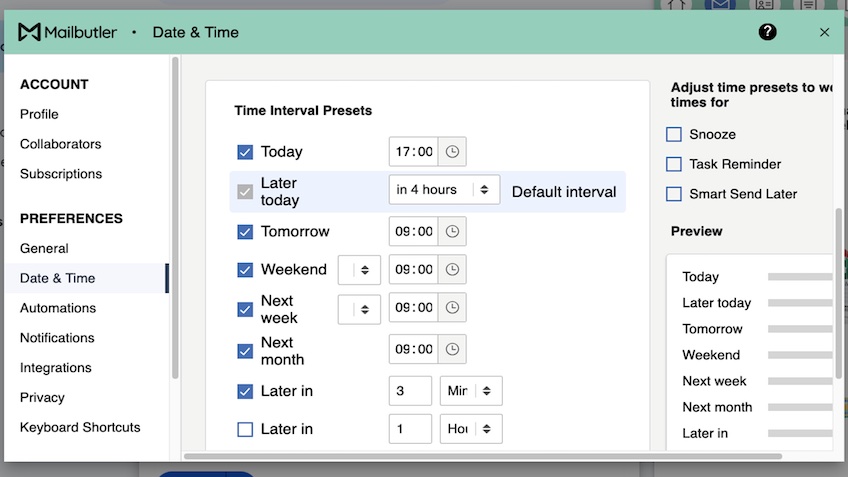
Signatures and templates: Mailbutler makes it easy to create professional email signatures and reusable templates.
For signatures, you can design customized branding and contact info, with full control over fonts, colors, and layout. Pre-made templates help get you started, and it’s easy to create on-brand signatures for your entire team.
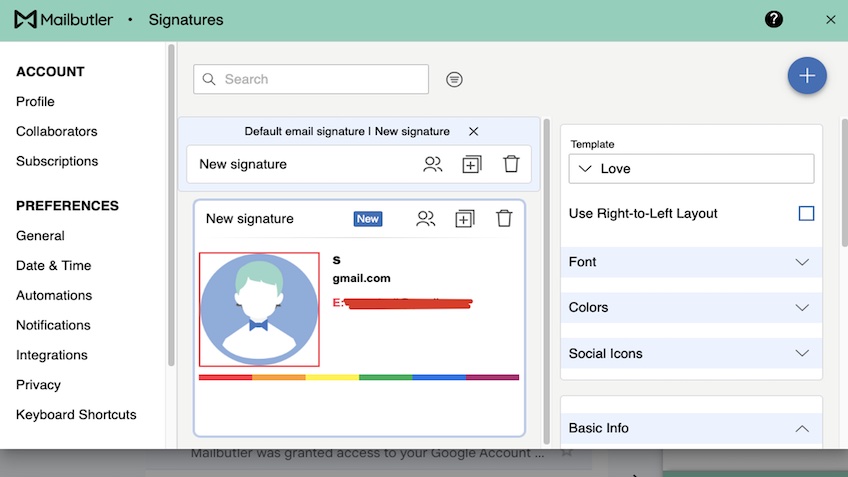
Similarly, Mailbutler’s email templates give you design options that allow matching fonts, colors, and branding to your existing assets and materials, keeping your communications visually aligned.
These email templates are useful for gaining quick access to pre-written message formats for common scenarios like follow-ups, invoicing, and more. Instead of writing everything from scratch each time, all you have to do is fill in the blanks.
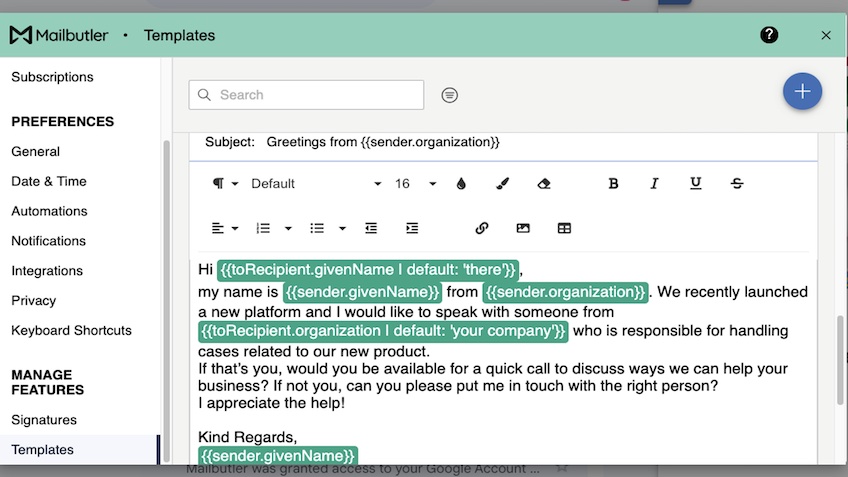
Signatures and templates also support adding images, logos, and social media links to enhance professionalism, and placeholder fields are at your disposal any time you want to send personalized copy.
Any changes you make to signatures and templates get synced across your entire team for consistency. For further collaboration, sharing access means any team member can leverage the templates to save time and sound polished. It also prevents messaging mistakes.
Between the reusable templates that minimize repetitive writing and the consistent signatures that present a professional front, Mailbutler helps streamline and strengthen your outbound communications.
Notes: Mailbutler’s notes feature grants you a clever way of attaching additional information to your emails and contacts.
You can create digital sticky notes to add key details, reminders, context, or anything else you want to remember about an email or contact.
These notes then become accessible in Mailbutler’s side panel whenever you open the associated email or contact card, so the information is right there when you need it. The notes themselves also support formatting options to emphasize key points, links, lists, and more.
For team collaboration, notes can be selectively shared with some or all teammates as needed, allowing everyone to stay in the proper loops.
Mailbutler also integrates with popular note-taking apps like Evernote and OneNote so that you can connect your email notes for unified access across all of your applications.
With the ability to share notes across your team, sync with external apps, and make private annotations to emails and contacts, Mailbutler’s notes provide a powerful way to attach supplemental information for greater context and organization.
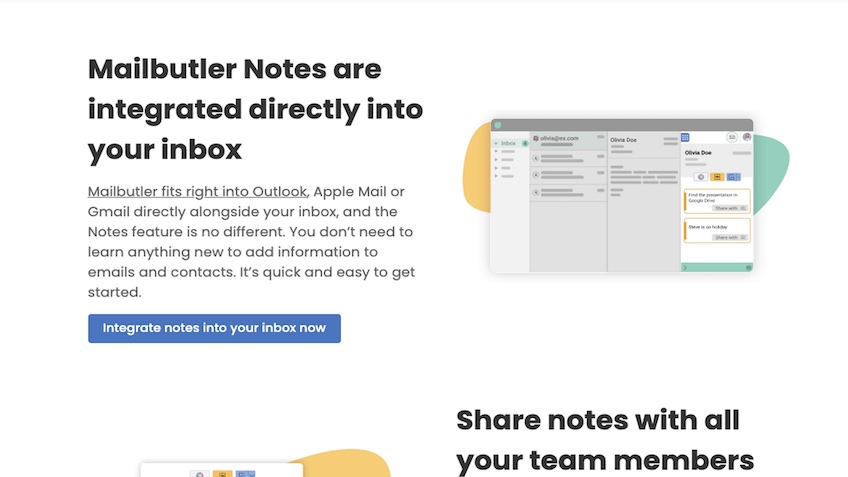
Tasks: Mailbutler makes it easy to turn your emails into actionable tasks. You can add tasks directly to any email or contact to capture follow-ups, reminders, or assignments. These action items then become trackable to-do list items.
Tasks can include customized due dates, notifications to help you remember, and automation rules like marking completed upon email reply receipt.
In order to provide unified task management, Mailbutler integrates your email tasks with your other productivity apps and calendars.
We liked that QuickTask options allowed easy creation of common tasks like follow-ups, recurring check-ins, and your most frequent requests with just a click.
By transforming emails into tracked tasks with reminders and integrations, Mailbutler helps ensure important actions don’t slip through the cracks. That way, emails drive productivity rather than get lost in the inbox overflow.
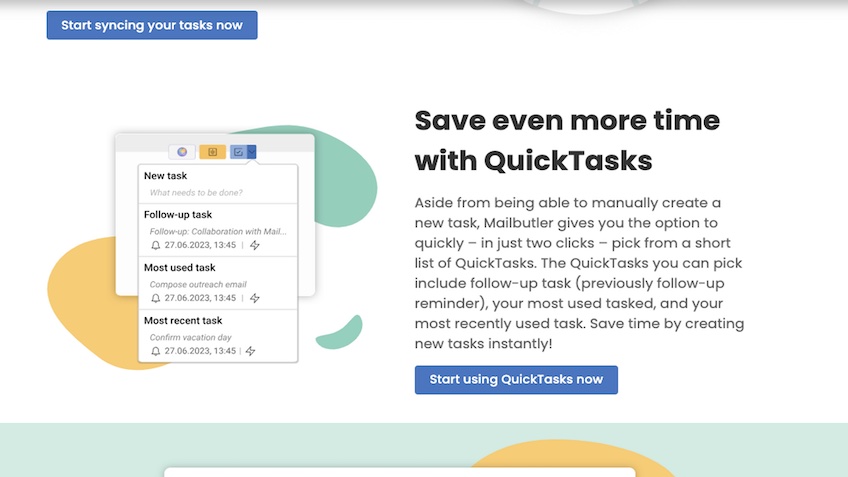
Snooze: Mailbutler’s Snooze feature lets you temporarily hide emails from your inbox until you’re ready to deal with them. If an email comes in that you can’t address right away, you can snooze it. This removes the message from your inbox for a set duration of your choosing.
Snoozed emails get saved into a dedicated snooze folder. They won’t get lost, but they also won’t clutter your inbox and distract you from the higher priority tasks you need to accomplish first. Once the snooze time is up, the email automatically returns to your inbox—but you can manually un-snooze a message whenever you want.
With customizable snooze durations and an organized folder, Mailbutler gives you more control over your inbox’s contents. You can cut through the noise and focus on what matters most in the moment.
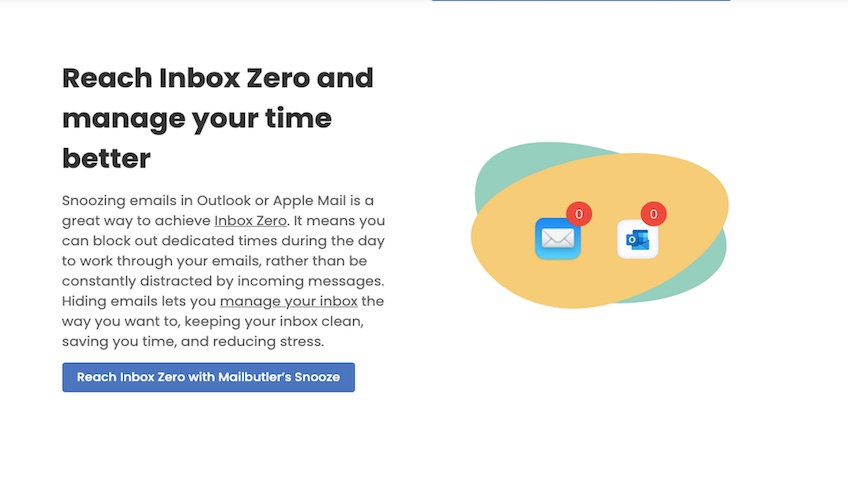
Smart Assistant: Mailbutler’s Smart Assistant leverages AI to automate and streamline various email tasks. It can generate entire emails from keywords you provide, allowing you to automate initial outreach and follow-up emails. You can always review and tweak before sending, however.
One of the more notable features of the assistant is the “Improve Email” feature, as it uses AI to fix spelling and grammar errors in an attempt to enhance the overall message quality. Instead of making the executive decision of changing things on its own, it instead highlights potential fixes for you to accept or reject. We made several intentional errors to see if it would catch them, and not a single one slipped through.
Another key feature of the assistant is the ability to summarize emails. The AI extracts key details into easily digestible bullet points, which is great for long messages so that you can save time and just read what’s important. This is a bit harder to test, so it’s hard to say if it’ll allow important details to slip through.
The assistant’s power doesn’t stop there. It can also populate contact cards automatically by scanning your email history for existing conversations. All their info and details are extracted and pulled in.
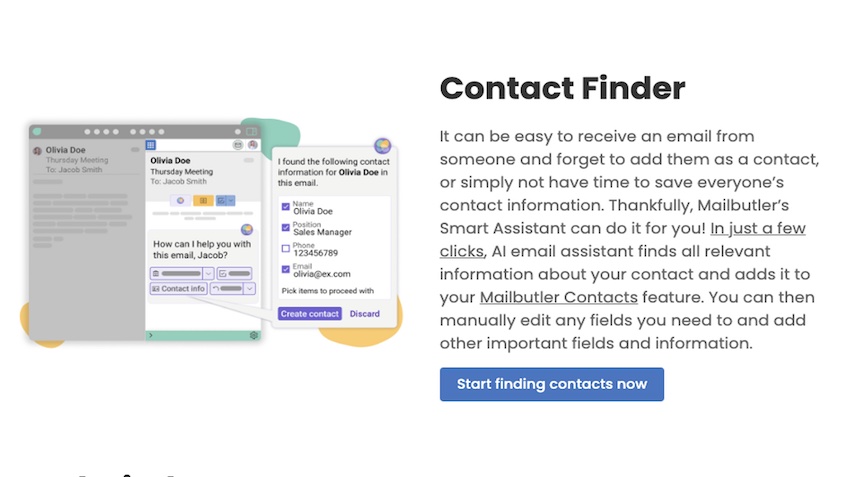
Extracting action items and to-dos from emails is another key feature of the assistant, which can automatically create new and relevant tasks to keep you productive.
With conversational email generation, proofing, summarization, contact finding, and task extraction, Mailbutler’s Smart Assistant streamlines tedious workflows and saves you time. It also integrates right into your inbox, too, so you’ll have access to all of its help without the need to change a thing.
